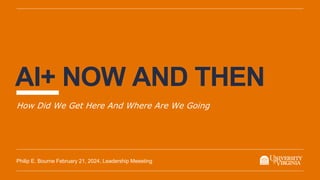AI+ Now and Then How Did We Get Here And Where Are We Going
- 1. AI+ NOW AND THEN How Did We Get Here And Where Are We Going Philip E. Bourne February 21, 2024, Leadership Meeeting
- 2. THE STUDENTS HAVE SPOKEN – Its here, it’s a tool – A tool like never before – How to relate to the honor code – Don’t get caught up in the hype – Wish professors knew more – Want to know more about the implications
- 3. HOW DID WE GET HERE? – AI consumes data of all types: 90% of the worlds data was generated in the last 2 years – Improved computer technology – Breakthroughs in algorithms and hence software providing persistent models A zetabyte is 1012 gigabytes
- 4. CONSIDER OUR FAVORITE EXAMPLE - – ChatGPT is one of many forms of AI – A Large Language Model – ”G” generative – ability to generate language, images, video, code … – “P” pre-trained – unsupervised learning on vast amounts of content – The training is done by neural networks that mimic the brain – learning by adjusting weights of each “neuron/node). Training stops when the right result is achieved. That network is then a model that can produce {mostly} the right answer from data it has never seen before – ”T” Transformers allow for parallel computation and treats text etc. as tokens ChatGPT
- 5. WHERE ARE WE HEADED? The current deep neural networks are equivalent to a rice grained size of the cerebral cortex and we are yet to explore most other aspects of brain morphology Terry Sejnowski https://www.pnas.org/doi/full/10.1073/pnas.1907373117
- 6. What Does This Mean in Practical Terms with AI+
- 8. RESEARCH A Biomedical Researcher The Holy Grail of Molecular Biology Food production Energy production Drugs … – Achieved by DeepMind (a Google spin off) not academia – 30 interdisciplinary scientists working together not competing – Compute power beyond a university
- 9. THREATS OPPORTUNITIES Creating new but different industries
- 10. How Disruptive Will It Be?
- 11. THE 6 D’S (PETER DIAMANDIS) Digitization Disruption Demonetization Dematerialization Democratization Time Volume, Velocity, Variety Digital media becomes bona fide form of communication Deception
- 12. KODAK – A 6D’S CASE STUDY Digital media becomes bona fide form of communication
- 13. WILL HISTORY REPEATS ITSELF? HIGHER EDUCATION Digitization Deception Disruption Demonetization Dematerialization Democratization Time Volume, Velocity, Variety AI impact minimal Models reach human capacity Augmented reality, sensors Quantum computing Digital media becomes bona fide form of communication Learning modalities change Knowledge workers must adapt job market shifts Robotics Research practice changes
- 14. THANK YOU Philip E. Bourne February 21, 2024, Leadership Meeeting
- 15. TWO DIFFERENT FUTURES ACCORDING TO DALL-E















